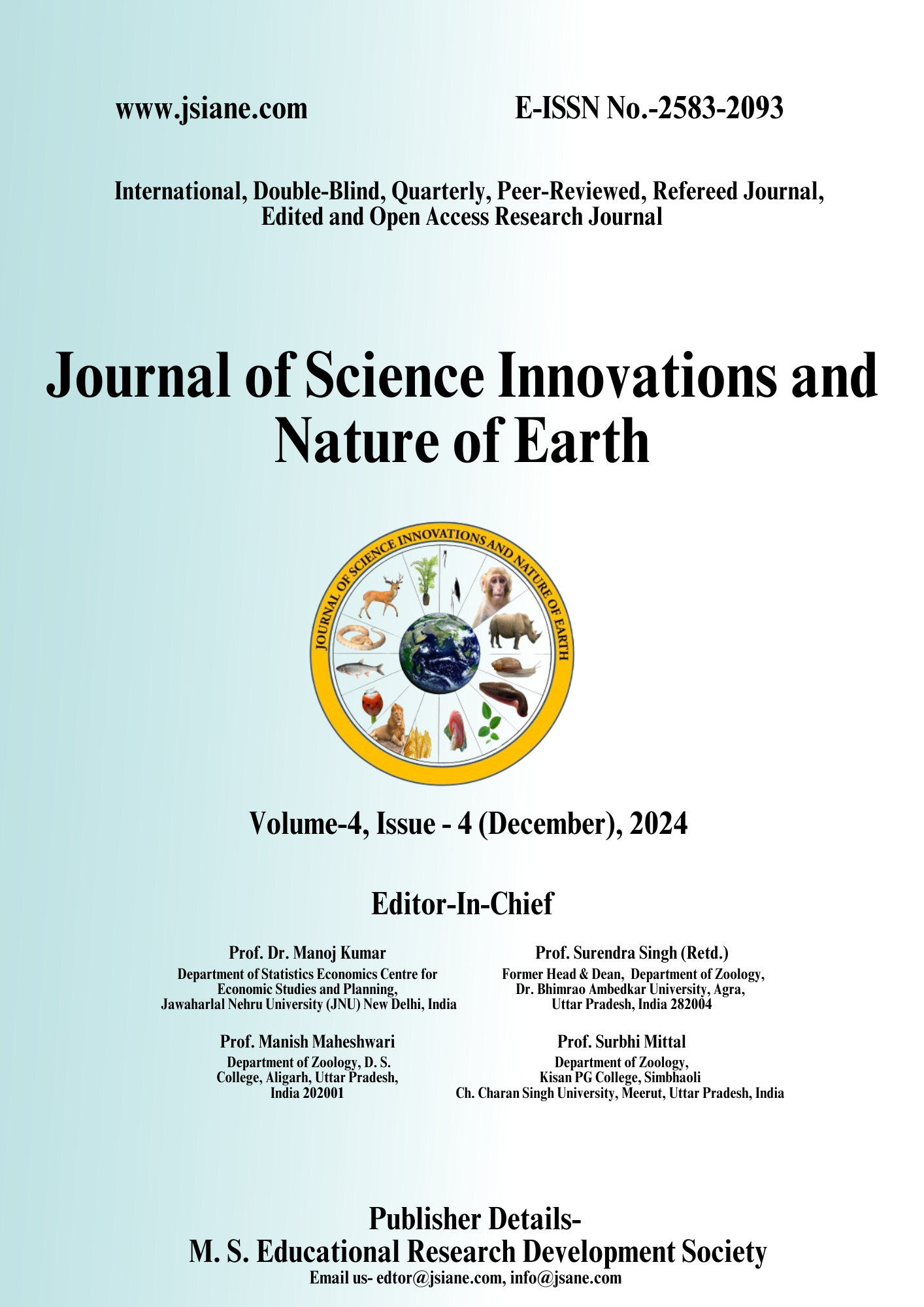Molecular Identification and Characterization of Cefalexin-Degrading Bacterial Isolates
DOI:
https://doi.org/10.59436/jsiane.342.2583-2093Keywords:
Antibiotic degradation, Cefalexin, Bioremediation, 16S rRNA, Molecular identification, Environmental microbiologyAbstract
The widespread and uncontrolled use of antibiotics in human and veterinary medicine, as well as agriculture, has led to the accumulation of antibiotic residues in various ecosystems, raising global concerns over environmental and public health. Cefalexin, a first-generation cephalosporin antibiotic, is frequently detected in wastewater, soil, and surface waters, where it contributes to the emergence and proliferation of antibiotic-resistant bacteria and resistance genes. In recent years, bioremediation using naturally occurring microbial populations has been recognized as a promising strategy to eliminate such contaminants. The present study focuses on the isolation, morphological, biochemical, and molecular characterization of cefalexin-degrading bacterial isolates from soil environments. A total of twelve cefalexin-tolerant bacterial strains were isolated and subjected to detailed screening. The study evaluated their growth behavior under various pH and temperature conditions, biochemical traits, and sugar fermentation profiles, and further identified potent strains via 16S rRNA gene sequencing. The findings revealed significant physiological diversity and robust adaptability among isolates, supporting their potential application in bioremediation strategies for mitigating environmental antibiotic contamination.
References
Akhtar, N., Amin, I., Nazir, R., & Jilani, G. (2022). Microbial bioremediation of pharmaceutical pollutants: A sustainable strategy for environmental clean-up. Environmental Research, 214, 113933.
Altschul, S. F., Gish, W., Miller, W., Myers, E. W., & Lipman, D. J. (1990). Basic local alignment search tool. Journal of Molecular Biology, 215(3), 403–410.
Aneja, K. R. (2003). Experiments in Microbiology, Plant Pathology and Biotechnology (4th ed.). New Age International Publishers.
Chen, Y., Liu, J., Xu, Y., & Li, J. (2023). Microbial responses to antibiotics in aquatic environments and their role in the degradation of emerging contaminants. Journal of Hazardous Materials, 449, 130829.
Clarridge, J. E. (2004). Impact of 16S rRNA gene sequence analysis for identification of bacteria on clinical microbiology and infectious diseases. Clinical Microbiology Reviews, 17(4), 840–862.
Fu, Q., He, J., & Ma, Y. (2015). Enrichment and acclimatization of antibiotics-degrading bacteria from contaminated environments. Bioresource Technology, 179, 110–116.
Gram, C. (1884). Ueber die isolirte Färbung der Schizomyceten in Schnitt‐ und Trockenpräparaten. Fortschritte der Medizin, 2, 185–189.
Hall, T. A. (1999). BioEdit: A user-friendly biological sequence alignment editor and analysis program for Windows 95/98/NT. Nucleic Acids Symposium Series, 41, 95–98.
Hassen, A., Saidi, N., Cherif, M., & Boudabous, A. (1998). Resistance of environmental bacteria to heavy metals. Bioresource Technology, 64(1), 7–15.
Holt, J. G., Krieg, N. R., Sneath, P. H. A., Staley, J. T., & Williams, S. T. (2004). Bergey’s Manual of Determinative Bacteriology (9th ed.). Lippincott Williams & Wilkins.
Jia, X., Zhang, Y., Xie, X., & Wang, Y. (2021). Biodegradation of antibiotics in the environment: A review on microbial and enzymatic processes. Science of the Total Environment, 757, 143911.
Khuntia, H. K., & Panda, S. (2021). Microbial degradation of antibiotics in the environment: Current advances and future perspectives. Environmental Advances, 5, 100092.
Kumar, M., Chaminda, G. G. T., Honda, R., & Furumai, H. (2021). Antibiotics in the environment: Threats and solutions. Environmental International, 146, 106199.
Kumar, S., Stecher, G., & Tamura, K. (2016). MEGA7: Molecular evolutionary genetics analysis version 7.0 for bigger datasets. Molecular Biology and Evolution, 33(7), 1870–1874.
Li, B., Zhang, T., & Xu, H. (2020). Occurrence and removal of antibiotic resistance genes in wastewater treatment plants. Water Research, 168, 115175.
Liu, M., Zhang, L., Yang, M., & Wang, Y. (2022). Biodegradation of beta-lactam antibiotics: Mechanisms and microbial degradation pathways. Journal of Environmental Chemical Engineering, 10(1), 106921.
Malik, A., & Jaiswal, R. (2000). Metal resistance in Pseudomonas strains isolated from soil treated with industrial wastewater. World Journal of Microbiology and Biotechnology, 16(2), 177–182.
Michael, I., Rizzo, L., McArdell, C. S., Manaia, C. M., Merlin, C., Schwartz, T., Dagot, C., & Fatta-Kassinos, D. (2021). Urban wastewater treatment plants as hotspots for antibiotic-resistant bacteria and genes spread into the environment: A review. Science of the Total Environment, 447, 345–360.
Niu, J., Wang, B., Zhang, Y., & Guo, Y. (2022). Enzymatic degradation of antibiotics by bacteria: Mechanisms and applications. Chemosphere, 286(Pt 1), 131755.
Pereira, A. M. P. T., Silva, L. J. G., Lino, C. M., & Pena, A. (2022). Environmental impact of antibiotics and resistance development in aquatic ecosystems. Environmental Pollution, 300, 118963.
Sanger, F., Nicklen, S., & Coulson, A. R. (1977). DNA sequencing with chain-terminating inhibitors. Proceedings of the National Academy of Sciences, 74(12), 5463–5467.
Singh, R., Singh, P., & Singh, H. (2023). Environmental antibiotics and their biodegradation by microbial consortia: An eco-friendly approach. Ecotoxicology and Environmental Safety, 252, 114524.
Studier, F. W., & Keppler, J. (1988). Sequence analysis and phylogenetic tree construction by the neighbor-joining method. Methods in Enzymology, 164, 285–294.
Ventola, C. L. (2015). The antibiotic resistance crisis: Part 1: Causes and threats. Pharmacy and Therapeutics, 40(4), 277–283.
Wang, Q., He, Y., Ma, H., & Xu, J. (2020). Biodegradation of antibiotics in the environment: Recent advances and future perspectives. Critical Reviews in Biotechnology, 40(1), 17–31.
World Health Organization (WHO). (2023). Antimicrobial resistance: Global report on surveillance. Retrieved from https://www.who.int/
Zhang, R., Zhang, G., Zheng, Q., & Tang, J. (2019). Occurrence and risk assessment of antibiotics in surface water and sediments from the East River (Dongjiang River), South China. Science of the Total Environment, 563–564, 448–455

Downloads
Published
Issue
Section
License
Copyright (c) 2024 Maharaj Singh Educational Research Development Society

This work is licensed under a Creative Commons Attribution-NonCommercial 4.0 International License.









